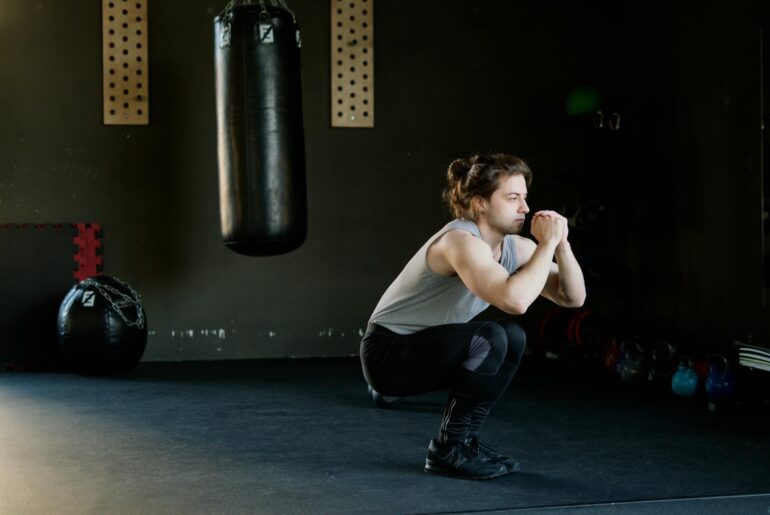The debate among Olympic lifters between front and back squats is a hot topic. Both exercises target major muscle groups like shoulders and strong legs. Back and front squat exercises are powerhouse moves targeting various muscle groups.
They differ in technique, muscle engagement, and step. Front squats emphasize the quads and core, while back squats target the glutes and hamstrings, major muscle groups in the legs.
Understanding the nuances between these two variations can help you optimize your workout routine and achieve your fitness goals more effectively.
Key Takeaways
- Understand the muscle activation differences between front and back squats to target specific muscle groups effectively.
- Focus on proper technique and posture to maximize the benefits and prevent injuries while performing squats.
- Avoid common mistakes like rounding the back or leaning too far forward to ensure safe and effective squatting.
- Tailor your squat based on your fitness goals: strength, muscle building, or overall functional fitness.
- Regularly incorporate squats into your routine for a well-rounded lower-body workout and improved overall strength.
- To optimize strength development, vary your squat techniques, rep ranges, and weights to challenge your muscles effectively.
Front vs Back Squat Overview
Benefits
Front squats emphasize quadriceps engagement, aiding knee stability and promoting an upright torso position. On the other hand, back squats primarily target the glutes and hamstrings, enhancing overall lower body strength.
Muscle Engagement
In front squats, the barbell is positioned on the front of the shoulders, prompting a more vertical torso angle and increased quadriceps activation. Conversely, back squats involve placing the barbell on the upper back, leading to greater hip involvement and emphasis on the glutes and hamstrings.
Weight Positioning
The weight distribution in front squats challenges core stability due to the forward bar placement, requiring a strong upper back to maintain proper form. In contrast, back squats place more load on the posterior chain, demanding robust hip extensor muscles for lifting heavier weights effectively.
Muscle Activation Differences
Quads and Upper Back
Front squats primarily target the quadriceps and upper back due to the barbell’s position in front of the body. This positioning forces the quads to work harder to lift the weight, resulting in greater quadriceps activation than back squats.
Posterior Chain Engagement
On the other hand, back squats heavily engage the posterior chain, including the lower back, glutes, and hamstrings. The barbell’s placement on the upper back requires these muscles to work more intensely, making back squats effective for overall lower body strength development.
Mobility Importance
Effective front squatting requires adequate mobility in various body parts, such as the wrists, shoulders, and thoracic spine. Limited mobility in these areas can hinder proper form and depth during front squats, potentially leading to discomfort or injury.
Technique and Posture Insights
Back Squat Execution
To perform a proper back squat, stand with your feet shoulder-width apart. Point your toes slightly outward.
Keep your chest up and look straight ahead. Place the barbell on your upper back, resting it on your traps.
Ensure your wrists are straight to effectively support the weight. Push your hips back and down as you descend while bending your knees. Maintain balance throughout the movement. Watch instructional videos for visual guidance.
Front Squat Form and Grip
For front squats, the key is to keep an upright posture throughout the movement. Hold the barbell in front of you with your elbows high to create a shelf to rest on. Your hands should be positioned just outside shoulder width. This grip helps maintain balance and stability during the exercise.
Posture and Movement Variances
The main difference between front and back squats lies in how the weight is distributed. In back squats, the emphasis is on hip movement initiation, engaging more of the posterior chain muscles. On the other hand, front squats require a more upright torso position, placing greater emphasis on quad strength and core stability.
Common Mistakes to Avoid
Back Squat
When performing back squats, one common mistake is allowing the traps to take over, leading to poor form. To rectify this, focus on engaging the core muscles instead. Another crucial aspect is maintaining a clean bar path throughout the movement.
Improper weight distribution can also hinder your back squat technique. Many people tend to shift their weight forward onto their toes, which can strain the lower back. Ensure your weight is evenly distributed across your feet to prevent this issue.
Front Squat
During front squats, it’s important to keep the elbows up high. Allowing them to drop can cause the barbell to roll forward, compromising your form. To help with this, work on wrist flexibility and upper back strength.
A standard error in front squats is leaning too far forward, which puts excessive pressure on the knees and lower back. To avoid this issue, focus on maintaining an upright torso position throughout the movement.
Significance of Proper Form
Maintaining proper form is crucial in both types of squats to prevent injuries. It not only helps in maximizing results but also ensures safety during training sessions. Remember, clean execution of squats is vital to reaping their full benefits without risking harm.
Benefits of Various Fitness Goals
Quad Development
Front squats are ideal for quad development due to the upright torso position, which places more emphasis on the quadriceps. This exercise targets the front of the legs, contributing to aesthetic goals.
Front squats engage the quads more than back squats, making them a preferred choice for individuals looking to enhance the size and strength of their quadriceps. The exercise also helps improve overall lower body strength and stability.
Strength and Power Gains
Back squats are renowned for building strength and power in the lower body. Back squats stimulate muscle growth and enhance overall athletic performance by allowing heavier weights to be lifted compared to front squats.
Incorporating back squats into a workout routine benefits athletes like Olympic lifters who rely on explosive power from the legs during lifts. The exercise engages multiple muscle groups simultaneously, promoting functional strength development.
Well-Rounded Fitness Routine
By incorporating both front and back squats into a training regimen, individuals can achieve a well-rounded fitness routine that effectively targets various muscle groups. Front squats emphasize quad development, while back squats focus on overall lower body strength and power.
Combining these two squat variations provides numerous benefits, including improved muscle balance, increased calorie burn, enhanced core stability, and better overall athleticism. A varied approach ensures that different fitness goals are addressed comprehensively.
Incorporating Squats into Your Routine
Tips for Effective Implementation
Start with proper form to integrate front and back squats into your workout. Keep your feet shoulder-width apart, toes slightly pointed outwards, and engage your core.
Ensure you maintain a neutral spine throughout the movement to protect your knees. Keep the barbell in the front rack position securely against your shoulders when performing front squats.
Variations to Enhance Your Routine
Add diversity to your routine by incorporating goblet, overhead, or Bulgarian split squats. These variations, like squatting, target different muscle groups and challenge your stability.
Experimenting with different squat variations prevents boredom and helps develop overall lower body strength and stability.
Balancing Front and Back Squats
For optimal results, balance the frequency of front and back squats based on your fitness goals. Consider alternating between the two types of squats within a training week to ensure adequate stimulation for muscle growth.
Balancing both types of squats can help achieve well-rounded lower body strength while reducing the risk of overuse injuries associated with focusing solely on one variation.
Tips for Optimal Strength Development
Progressive Weight Increase
To effectively enhance body strength, focus on gradually adding weight to your back squats. Start with a weight that challenges you but allows for proper form. Slowly increase the load as you build strength and stability. Avoid drastic jumps in weight to prevent injuries and ensure steady progress.
Stability and Control in Front Squats
Improving stability and control during front squats is crucial for maximizing strength development. Maintain an upright torso position throughout the squat movement to engage core muscles and effectively target the quads. Practice proper breathing techniques to support stability and balance, enhancing overall performance.
Rest Periods and Recovery Techniques
Adequate rest periods are essential for muscle growth and strength gains from squats. Allow your muscles to recover between sets to prevent fatigue and optimize performance. Incorporate active recovery strategies such as foam rolling, stretching, and adequate hydration to support muscle repair and growth.
Choosing the Right Squat for You
Mobility Considerations
When deciding between front squats and back squats, assess your mobility. Front squats require more excellent wrist, shoulder, and thoracic spine mobility. On the other hand, back squats demand more ankle and hip flexibility.
Prioritize front squats if you have good shoulder mobility but struggle with lower body flexibility. Opt for back squats if ankle or hip mobility is a limiting factor in your squatting technique.
Injury History and Personal Preferences
Consider your previous injuries when selecting a squat variation. Front squats can be gentler on the lower back due to the more upright torso. Conversely, back squats may place more stress on the lower back but effectively engage the posterior chain.
Personal preferences also play a crucial role. Some individuals feel more comfortable and stable with front squats, while others prefer the feeling of power generated from back squats.
- Front Squat Pros: Greater core engagement, emphasis on quadriceps, less strain on the lower back.
- Back Squat Pros: Higher loading potential, activation of glutes and hamstrings.
Summary
You have now comprehensively understood the differences between front squats and back squats, from muscle activation to proper technique and common mistakes. By learning about each type’s benefits for various fitness goals and how to incorporate them into your routine effectively, you can optimize your strength development.
Remember to focus on choosing the squat variation that aligns best with your goals and body mechanics for maximum results. Whether you aim to build muscle, improve athletic performance, or enhance overall fitness, the proper squat can be a powerful tool in your training arsenal.
Frequently Asked Questions
What are the critical differences between front squats and back squats?
Front squats target the quads more, require more excellent core stability, and put less stress on the lower back than back squats. Back squats engage more of the posterior chain, allowing for heavier loads due to better leverage.
Which squat variation is better for muscle activation?
Front squats emphasize quad activation, while back squats engage the hamstrings and glutes. Both are effective, but front squats are preferred for targeting the quads.
How can I avoid common mistakes when performing front or back squats?
To avoid common mistakes like improper spine alignment or excessive forward lean, focus on maintaining a neutral spine, bracing your core, and ensuring your knees track in line with your toes during both front and back squats.
Can I incorporate both front and back squats into my workout routine?
Incorporating front and back squats into your routine can provide a well-rounded lower-body workout. Consider alternating between the two variations, like squats, to effectively target different muscle groups.
What tips can help me develop optimal strength through front and back squats?
Focus on proper form, gradually increase weights to challenge yourself, incorporate variations like tempo squats or pause squats, ensure adequate rest for recovery, and maintain consistency in your squat training to achieve optimal strength development.











